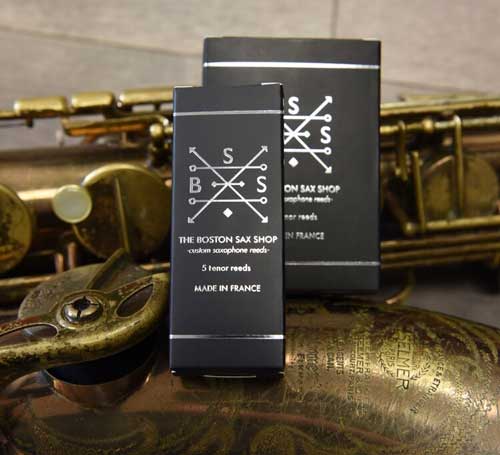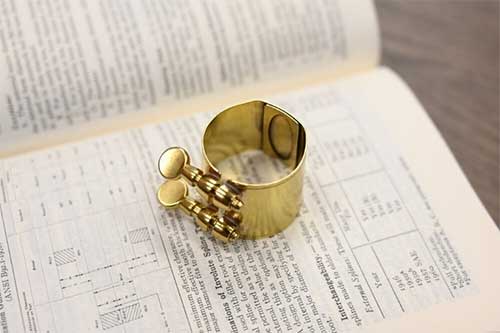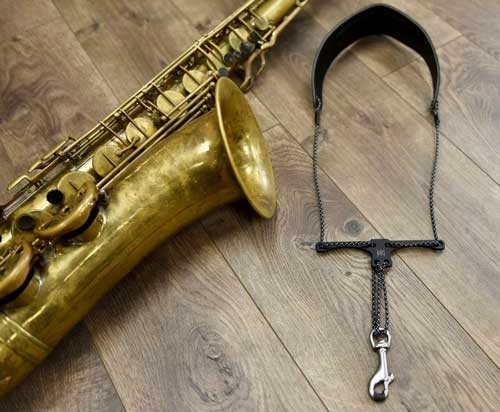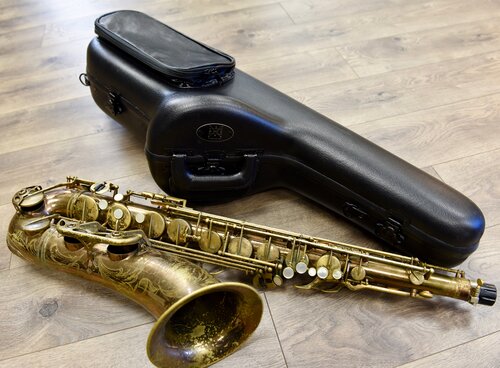The Gear Behind the “Buzz” Around B.S.S (Boston Sax Shop)
I have been following Jack Finucane at the increasingly-popular Boston Sax Shop for quite some time. Since the introduction of the Balam Back Strap, Jack has expanded his product line to include his own necks (Heritage Neck), neck-straps (Newbury Street & Deluxe), cases (Ambassador Case for tenor and alto), reeds (B.S.S.), and most recently his new B.S.S Superlative ligature. In this article, I will be providing an overview as well as my experience thus far using all of these products over the past few months (excluding the Heritage Neck-currently on back-order).
Boston Sax Shop Custom Tenor Reeds

Product Overview
Jack informed me that he decided to design his own line of reeds because although he mainly focuses on repair work, he is a player and like many of us, was frustrated that he could not find the perfect or close to perfect reed. For the reed design, Jack was looking to create a cut that offered the player a well-balanced reed (even-sounding lows, mids, and highs) with a warm sound and a good amount of projection so you could cut when needed. Jack found the current jazz reed options available today were either too buzzy or bright, while the classical reed offerings, on the other hand, had the core and depth that many players are looking for, but they would not cut through the noise when needed. Through Jack’s research, the Boston Sax Shop reed was born. The B.S.S reed is a combination of both a classical and a jazz cut, resulting in a reed that provides a warm and dark tone while providing the player with a reed that can project when pushed instead of thinning out.
Verdict
I have been playing a wide assortment of different jazz-cut reeds for some time, including brands such as Rigotti, Lupifaro, Vandoren, D’Addario, Ishimori, Roberto’s, Alexander, and the list goes on. Generally speaking, these have been working well for me but I, being a bit of a gear enthusiast (with the descriptor, “enthusiast” being an understatement), was curious how the B.S.S. reeds would perform.
I decided to order a box of five reeds in 2 strength, and five more in 2.5 strength. Since Jack informed me that the B.S.S reed is an unfiled cut with a thicker tip, I might find the 2.5 to play a bit harder than other 2.5 cuts. When I received the B.S.S reeds and started playing the 2 and 2.5, I realized the 2 was, naturally, a more free-blowing reed, but overall, I preferred the level of feedback and buzz I got when playing the 2.5 cut.
Just as Jack described, the B.S.S reeds had a dark and warm tone, but with a brighter setup, you could get a lot of edge in your sound. I did find that the five 2.5 B.S.S reeds played consistently overall, but due to their thicker tip, I decided to use my ReedGeek to further flatten the table and clear up the tip so it would play a bit less resistant.
Since playing these reeds over the past few months, I will say if you maintain these reeds (Reedcase or ReedGeek), you will see quite a long shelf life on each reed (one in particular I have been playing for 3.5 months and it has been holding strong). If you, like me, are currently a fan of Rigotti cane, then these B.S.S reeds are a must-try.
Some of the high-profile players using B.S.S Custom include Ben Wendel, Melissa, Aldana, Braxton Cook, Jeff Coffin, and Joel Frahm, to name just a few players who have made the switch. I am looking forward to checking out the alto, soprano, and baritone reeds in the future to see how they compare.
Link: Boston Sax Shop Custom Reeds
Boston Sax Shop Newbury Street Deluxe Neck-Strap
Product Overview
There are so many neck straps on the market today that it can be challenging to decide which one will work best for you. At the 2019 NAMM Show, I had the chance to check out the Balam Back Strap which I quite liked in terms of look, feel, and support, so I decided to pick one up. I later learned that in addition to the Balam Back Strap, Jack also offered his own line of neck straps which included two models: The Newbury Street Strap & The Newbury Street Deluxe Strap. I have seen various vendors offer similar neck-straps but, I found Jack’s neck straps to include all the features many of us horn players are looking for.
The Newbury Street Deluxe neck strap offers two different types of leather, both of which don’t stretch or bounce when you attach your saxophone, and also contain a wedge of memory foam for comfort and support. The string is a 550 paracord, which is more than strong enough to support double the weight of the saxophone. The slider is cast in brass with a powder matte black finish and provides easy adjustment depending on which saxophone you are switching too. Finally, the hook (very important) is a combination of metal and plastic. The metal hook is covered in industrial strength tubing which will prevent wear on your saxophone neckstrap ring, which means you do not have to be concerned with some of the issues a plastic hook faces (bending or not fully closing over time).
Verdict
Overall, I am very happy with the Newbury Street Deluxe neckstrap. I am currently playing on a Saxholder strap which I still feel provides me some additional neck support over the Newbury Street Deluxe but, the Newbury Street Deluxe is easier to adjust and simply more aesthetically pleasing while playing standing up or sitting down. I really enjoyed the adjustment slider which made it easy to adjust back and forth without it getting caught or stuck at certain spots – which is an issue I have run into with other neckstraps. The coating on the hook is a great idea and something I wish more manufacturers offered.
Although the neckstrap is seen as a simple piece of equipment, I really think it is important to invest in a good quality strap because it will save your neck in the long run (pun intended). I would recommend choosing the Deluxe version if you prefer the slider but, if you want a more traditional neckstrap (similar to a Oleg, Just Joe’s, etc.), then the Newbury Street will work just fine.
Link: Newbury Street Deluxe Strap
Boston Sax Shop Superlative Ligature (Tenor)

Product Overview
I recall trying one of the first prototypes of the Superlative Ligature back at the NAMM show a year ago, and was impressed with the prototype’s design, material, and construction. Jack informed me that the Superlative ligature actually started as a midnight sketch on the back of a cocktail napkin at the 2018 NAMM Show. Jack told me he really wanted to create a simple but solid, practical, and vintage-inspired ligature that he felt was missing on the market today. The design concept drew from some of Jack’s favorite ligatures, which were the: Selmer ‘2 Screw’, Magnitone and Harrison.
After 2 years of prototyping and gaining feedback from players, the Superlative ligature was born. The Superlative ligature features: “a single piece body design made up of 3 distinct radiuses that allow for plenty of reed/mouthpiece vibration while being solid and stable fitting on the mouthpiece.” The reed contact plate (see picture above), grips evenly while giving the middle section of the reed room to breathe. Jack discovered while designing this ligature that this was a common area where a new reed would swell which resulted in a non-optimal seal. The two screw inverted orientation over the traditional two screws at the bottom was for simplicity and easy adjustment.
In addition to the bare brass finish which will age over time, Jack also offers a ‘hand finished’ option which involves adding a jewelry technique finish called “stippling” to the outside of the ligature. Each one is individual and personally done by Jack. The ligature comes in three finishes: bare brass, silver plate, and gold plated. The Superlative ligature fits a wide variety of hard rubber mouthpieces but if you don’t see your mouthpiece listed, feel free to reach out to the Boston Sax Shop and they will be able to confirm if the ligature is a fit or not for your particular mouthpiece. I would also like to give a quick shout out to Derek at SaxSpy who did a great overview of the Superlative ligature if you have not already checked it out.
Verdict
Before picking up the Boston Sax Shop Superlative ligature, I was playing on an Ishimori Sterling Silver ligature (which has been working great for me) for my hard rubber slant link. When I received the Superlative ligature, it was just like Jack described and reminded me of a combination between a 2 -crew Selmer ligature, Ishimori (in terms of screws and bottom plate), and the Aidu ring ligature.
The overall construction of the Superlative ligature was great. I did not find the brass ring or screws to be thin and bendable, but instead, solid and machined well. The Superlative ligature fit my Link very nicely, and was easy to adjust – in no small part due to the neck plate design. I noticed that the ligature held the reed intact when tightened, but did not overly constrain, as the reed with the bottom left and right side showing a little bit of space to allow the reed to vibrate.
When I started to play, I noticed the Superlative ligature really allowed the reed to vibrate which I believe contributed to a bit more projection and volume in my sound. Sonically, I found the low, mids, and highs to play even, but noticed my highs popped a little bit easier. I found the Superlative ligature allowed me to obtain a nice core sound even with the further vibration which I thought would have made my sound more spread.
Overall, I am really happy with how the Superlative ligature came out, from the material, to design, to fitting, to the impact on my sound. If you are looking for a ligature and have a budget of under $100 dollars, I would definitely consider the Superlative ligature (mind you, only the brass finish is under $100, the other finishes are a bit more). Its simple design, solid construction, and overall playability is something I think many hard rubber tenor players will enjoy.
Link: Boston Sax Shop Superlative Ligature
Boston Sax Shop Ambassador Case (Tenor)
Product Overview
In the time since I first saw the Ambassador alto case at the 2019 NAMM Show, Jack has released a tenor version. Similar to the alto version, the tenor version is made from a composite structure and wrapped in a hard wearing automotive interior grade synthetic leather which results in lightweight but very durable case. The hardware is made up of all steel and utilizes a full length piano style hinge with four butterfly latches that require a two stage locking operation (this helps prevent the latch from accidentally opening).
The interior of the Ambassador case features a medium firm, memory style foam which delivers a tight and proper fit so your saxophone is not moving while you go from gig to gig. You have the option to go with or without the exterior pouch, but if you go with the exterior pouch option, you will have extra space for storing your reeds, mouthpiece, ligatures, and other accessories. One final feature which I know many of us saxophonists will enjoy is the ability to add padded backpack straps with locking carabiners in addition to braided steel wire loops that act as a failsafe for the unlikely event of strap failure.
Verdict
I was currently using a Bam Softpak case which served me well from high school to post-college, but it was showing signs of wear with the foam as well as interior starting to deteriorate. I had always heard good things about the Walt Johnson case, which does provide solid protection, but after seeing one up close, I found it to be quite heavy and not as compact as my Bam case. When I received the Ambassador tenor case, I felt I got the best of both worlds. The Ambassador tenor case provided me the compact and slim profile that I was looking for (especially when taking my horn on an flight), but also the protection that the Walt Johnson could offer. I decided to get the Ambassador case without the exterior pouch for a slimmer profile, but will say that if you carry lots of extra reeds, neckstraps, mouthpieces, or other accessories, you will want the pouch for the extra storage. The four butterfly latches that come on the Ambassador case really provide a secure lock so you don’t have to worry about a latch accidentally coming undone.
What’s also great is that if you latch one or two butterfly latches but forget to close the third and fourth latch by accident (obviously not recommend) the case won’t pop open with your horn unfortunately falling to the ground. The interior foam fit my tenor snug and securely, but I would recommend also using an end cap or even the GapCap by Key leaves, as either of those will further help take up the little bit of space left so your horn will not move.
The velvet bag that comes included with the Ambassador case does provide enough space for you to put your neck and mouthpiece securely within the bell and even, depending on how you store your reeds, a little space above to put a reed case (this is where the pouch comes more in handy).
Overall, I am really happy with how the Ambassador tenor case came out since checking out the alto version. I think Jack’s case is a great option for players who are looking for an off-the-shelf case that provides solid protection, is comfortable and light to carry around (backpack straps also help), and most importantly, provides a slim profile so it’s easy to travel when needed.
Links: B.S.S Ambassador Case
Final Takeaways
It is not often to see an independent music shop producing a full line of products that so many musicians are using and excited about. Since attending multiple NAMM Shows and searching the web for new products, I am seeing a further consolidation with more and more manufacturers who previously specialized in just one type of saxophone product, be it a saxophone manufacturer, a reed manufacturer, a neckstrap manufacturer, etc. (mainly talking about the large players) starting to brand themselves as a one-stop shop for all saxophone related products. Although this would seem like the right move, I have seen many manufacturers dive into producing a full product-line without the right amount of R&D and artist feedback, so some of their new products end up being a copy of an existing product, or a sub-par offering that does not help strengthen their current brand and position. Since seeing Jack introduce his own line of neckstraps, cases, reeds, and most recently, his ligature, I have come to realize that it is possible (even as a small shop), with the right R&D and artist feedback, to produce a unique, high-quality product line that can further evolve and grow over time.
I have had the opportunity to try every product that the Boston Sax Shop offers, and my overall experience, as well as what I’ve gathered from speaking with others that are also using B.S.S. products, has been overwhelmingly positive. In fact, I am now using Jack’s reeds, ligature, and his Newbury Street Deluxe Strap, and am very happy with all three.
For those players who are interested in exploring new sax gear, I would highly recommend the Boston Sax Shop line of products because the attention to detail, quality, and overall value is simply hard to beat.
I would like to thank Jack Finucane for sharing further details on each of his products, and am eagerly awaiting the return of the Heritage Necks, which happen to be out of stock at the time of this writing.
Click here to learn more about Boston Sax Shop at its official website.









January 19, 2021 @ 11:07 pm
It’s great that BSS offers a neck strap with a yoke-mounted slider. The more common narrow mount can affect the position of the strap on the shoulders, with more of a tendency to ride up on the neck in an up-adjusted position, as the ends of the neckpiece are more drawn together. Not a huge deal, but it means that proper sizing of a non-yoke strap is more critical, to avoid excessive up-adjustment. In short, the yoke mount allows a greater range of adjustment that will maintain an optimal neck position for comfort. Something doublers should definitely consider.
I think BSS’s choice of plastic tubing at the contact point of a steel hook is, unfortunately, wide of the mark. A better choice would have been to use a brass hook, as brass is softer than steel and the hook, rather than the strap ring, will absorb the wear of metal-on-metal contact. The plastic could eventually wear through, exposing the strap ring to steel. Also, plastic at the point of contact could dull the sound per this thread:
https://www.bestsaxophonewebsiteever.com/does-your-neck-strap-contain-a-hidden-power-to-improve-your-sound/
In my experience, the sonic benefit of having the strap ring hanging off a large metal hook is a real thing.
Up and Comer Ryan Devlin on How Many Hours to Shed, the Impact of Quality Gear, and Much More » Best. Saxophone. Website. Ever.
August 28, 2021 @ 10:26 am
[…] reason I decided to go to NEC was since joining Boston Sax Shop as an artist, this would allow me further work with Jack and I have already been doing a lot of […]